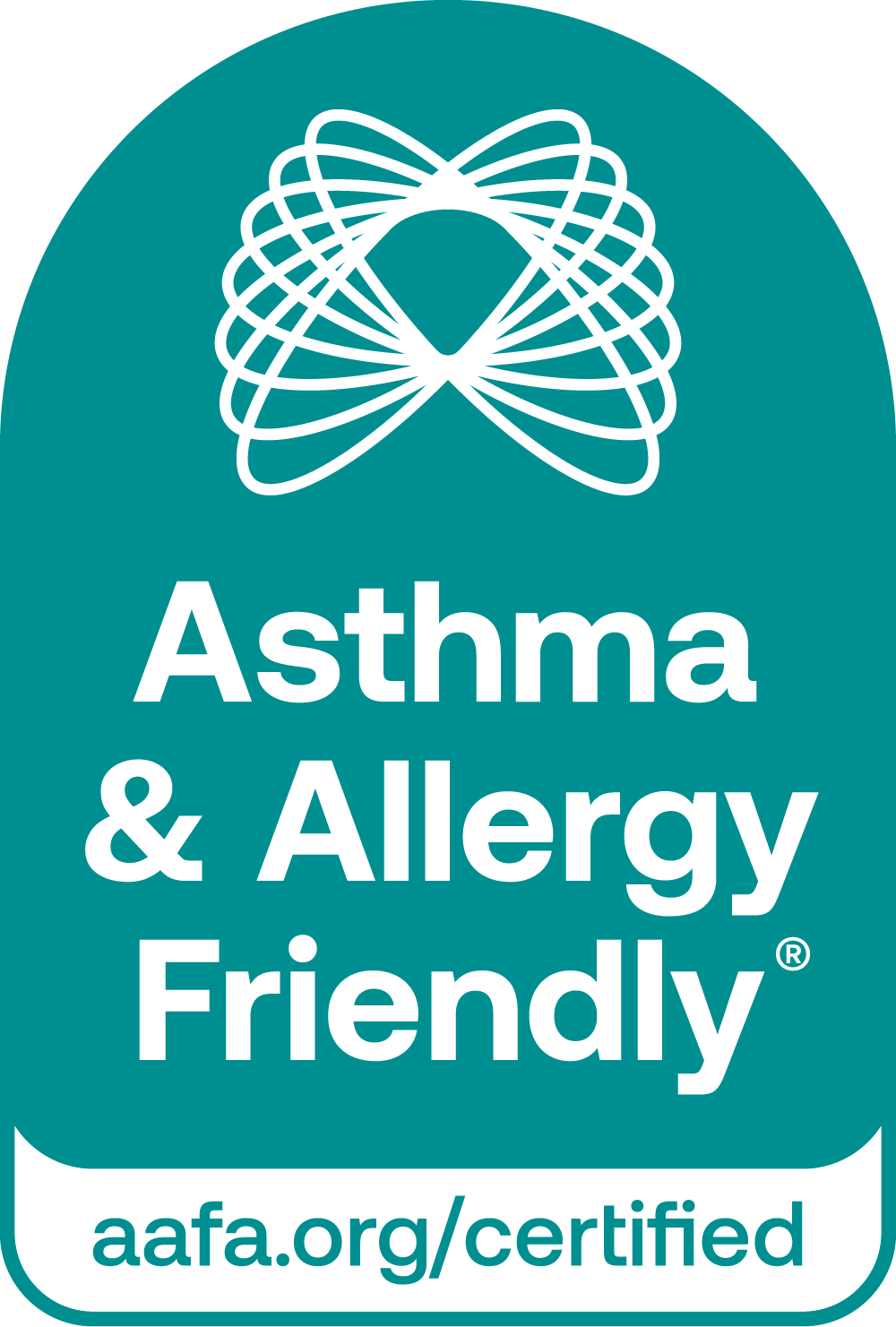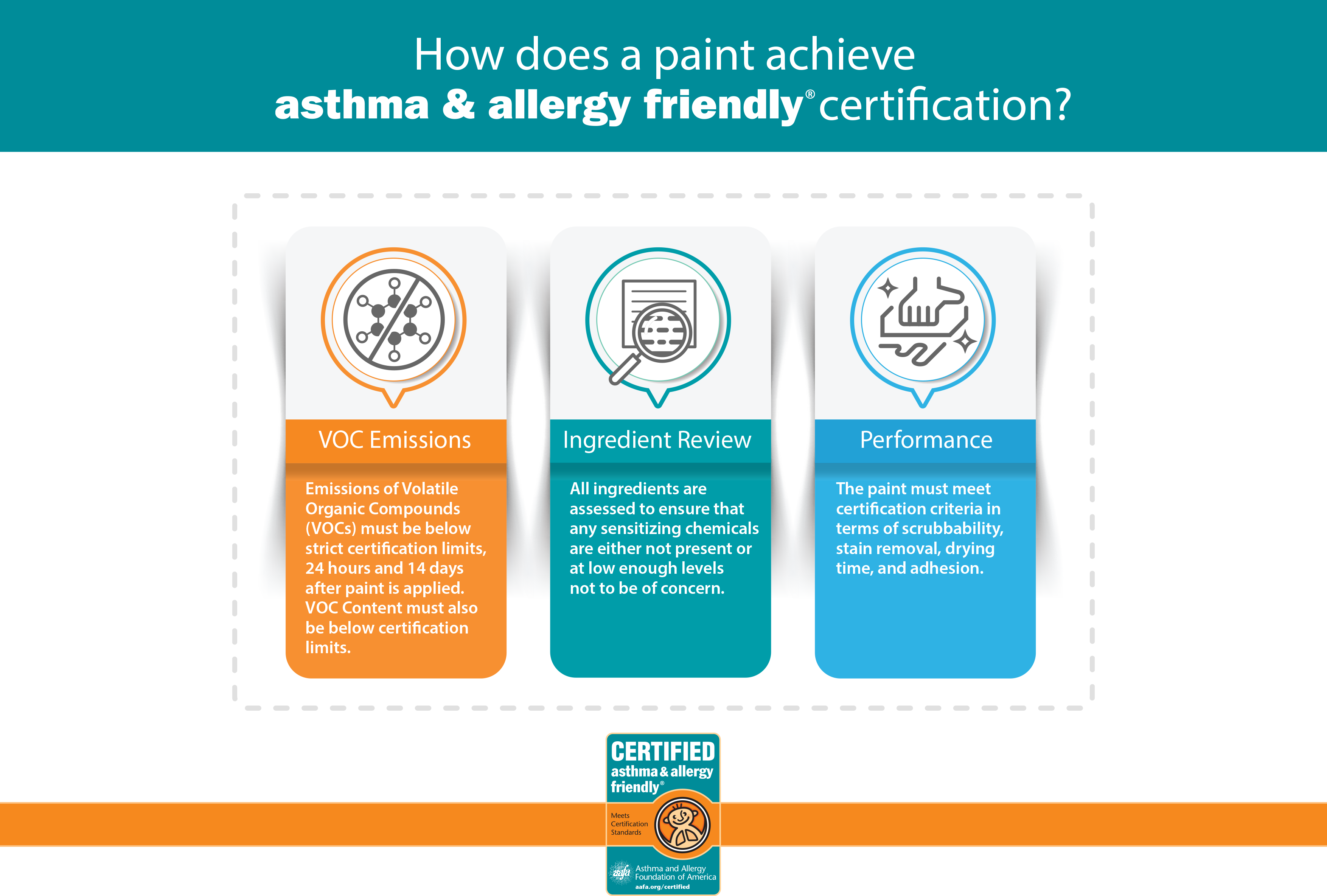How Choosing Third Party Certified Paints Can Improve Indoor Air Quality and Support Healthier Living Environments
October marks Indoor Air Quality Awareness Month, a time to reflect on the various factors that impact the air we breathe inside our homes. Paint can be a significant contributor to indoor air quality (IAQ), as it releases chemicals into the air during and after application, which can affect health, particularly for individuals with asthma or allergies. Choosing the right paint can help minimize these risks. This article explores how paint impacts IAQ, the importance of third-party certification, and why Asthma & Allergy Friendly® Certified paint is an excellent choice for healthier indoor environments.
Paint and Indoor Air Quality
The primary way paint impacts indoor air quality is through the emission of chemicals, particularly volatile organic compounds (VOCs). VOCs are chemicals that evaporate into the air as paint dries. While some VOCs are relatively harmless, others can cause significant health issues, especially for those with asthma or allergies. According to the U.S. Environmental Protection Agency, exposure to VOCs can cause “eye, nose, and throat irritation; headaches, dizziness, and nausea,” and in extreme cases, long-term damage to the liver, kidneys, or central nervous system. It is advised that people with sensitivities to certain chemicals and those impacted by asthma and allergies limit exposure to VOCs as much as possible. However, considering their potential harmful effects, everyone should limit exposure to these chemicals.
VOCs are particularly concerning because they continue to off-gas even after the paint dries. This means that while the smell of fresh paint may dissipate after a few days, harmful chemicals may still linger in the air. For individuals with sensitive airways, such as those with asthma, these chemicals can exacerbate symptoms or trigger asthma attacks.
In response to growing consumer awareness, many paint manufacturers have developed low-VOC options. These paints, predominantly water-based, significantly reduce the amount of harmful emissions, making them a better choice for improving IAQ.
The Importance of Third-Party Certification
While many paint products claim to be ‘low-VOC’ or ‘non-toxic’, not all of them meet the stringent criteria necessary to ensure safety and performance. This is where third-party certification comes into play. Third-party certification programs, such as the Asthma & Allergy Friendly® Certification Program, test products against independent standards to confirm manufacturers’ claims. Manufacturers can voluntarily submit their paints for independent testing, and if the product meets the standards, it can be awarded a certification.
For consumers, third-party certification provides peace of mind that the product they are using has been rigorously tested. Third-party certification is crucial because many paint manufacturers don’t fully disclose their ingredients, often to protect intellectual property. This lack of transparency makes it difficult for consumers to avoid harmful chemicals on their own. A trusted certification label helps bridge that gap, guiding consumers toward wiser choices for better indoor air quality.
The Asthma & Allergy Friendly® Certification Program

The Asthma & Allergy Friendly® Certification Program takes a balanced approach when certifying paints, considering both their chemical composition and performance. It’s not possible to make paint without using chemicals, and some chemicals may have some negative effects but are necessary for the product to function effectively.
The program identifies paints that do not contain unnecessarily harmful ingredients and ensures that any necessary chemicals that could cause allergic reactions are present at levels low enough to minimize concern. This thorough review makes Certified paints a better option for all consumers, particularly those with asthma or allergies.
Certified paints are subject to testing beyond standard VOC emission tests. The Asthma & Allergy Friendly®Certification Program measures VOC emissions at 24 and 14 days after application, ensuring that VOC levels remain low from the outset. Though the majority of VOC off-gassing typically happens during the first week after painting, surfaces can continue to emit potentially harmful VOCs for much longer. Many standard certifications only test after a 10-day conditioning period, which may not reflect real-world usage, where immediate air quality is a concern for consumers painting their own homes.
The Broader Impact of Paint Certification
The Asthma & Allergy Friendly® Certification Program works with major paint manufacturers to certify their products. These companies recognize the importance of reducing their environmental footprint while also improving IAQ for their consumers. By achieving certification, they demonstrate a commitment to corporate responsibility and consumer well-being. With their focus on the planet, sustainability, and people, they are paving the way for all paint manufacturers.
As more consumers become aware of the negative environmental and health impacts of conventional paints, the demand for superior products grows. Certified paints play a vital role in the healthier buildings movement. Studies show that indoor air can be two to five times more polluted than outdoor air, and with people spending up to 90% of their time indoors, it’s crucial to reduce exposure to potentially harmful chemicals. Certified paints contribute to creating healthier homes, schools, and workplaces.
Conclusion
Paint may seem like a simple home improvement product, but its impact on indoor air quality is significant. VOC emissions from conventional paints can lead to a range of health issues, particularly for individuals with asthma or allergies. Fortunately, advancements in paint technology and the availability of third-party certification programs make it easier than ever to choose better options.
The Asthma & Allergy Friendly® Certification Program helps consumers identify paints that are independently tested for low emissions and high performance. Indoor air quality is of particular concern for those affected by asthma and allergies, but a healthier home is beneficial for everyone.

